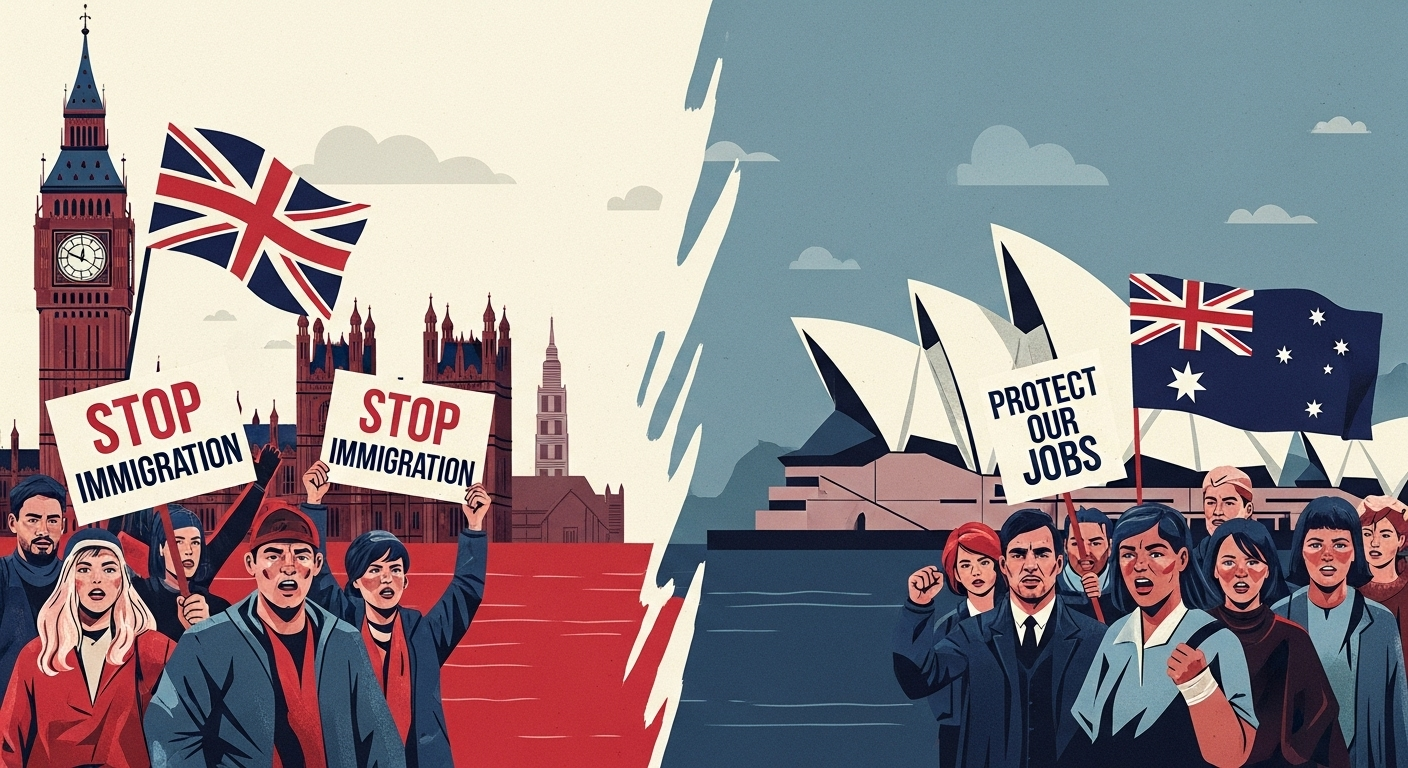
Anti-Immigration Meaning, Protests in the UK & Australia Explained
Table of Contents
- Introduction
- What Does Anti-Immigration Mean?
- Historical Background of Anti-Immigration Movements
- Anti-Immigration Protests in the UK
- Anti-Immigration Protests in Australia
- Public Opinion vs. Political Rhetoric
- The Impact of Anti-Immigration Protests
- Comparing UK and Australia Movements
- Is Anti-Immigration Sentiment Growing Worldwide?
- Counter-Movements and Pro-Immigration Protests
- Future of Immigration Policies
- Conclusion
- FAQs
Introduction
Immigration has always been one of the most debated topics worldwide. While many see it as a way to enrich cultures and boost economies, others fear it threatens jobs, national identity, and security. These opposing views often spark anti-immigration protests, especially in countries like the UK and Australia. But what does “anti-immigration” really mean, and why do protests keep happening? Let’s break it down.
What Does Anti-Immigration Mean?
Definition of Anti-Immigration
Anti-immigration refers to a political or social stance opposing immigration or the settlement of foreign nationals within a country. It doesn’t always mean total rejection of migrants but often argues for stricter border controls, reduced migration numbers, or prioritizing locals over immigrants.
Core Beliefs of Anti-Immigration Movements
These movements are usually driven by economic, cultural, or security concerns.
Concerns Over Jobs and Economy
A common argument is that immigrants “take away jobs” from locals or strain public services like healthcare, housing, and education.
Cultural Identity and Social Change
Many believe too much immigration alters a nation’s cultural identity, traditions, and language, leading to social friction.
Historical Background of Anti-Immigration Movements
Early Immigration Policies in Europe and the UK
The UK has a long history of migration, from post-WWII workers from the Commonwealth to EU free movement. Anti-immigration movements grew stronger during economic recessions and spikes in immigration.
Anti-Immigration Roots in Australia
Australia introduced the infamous “White Australia Policy” in 1901, restricting non-European immigrants. Although abolished decades ago, its legacy still influences debates today.
Anti-Immigration Protests in the UK
What is an Anti-Immigration Protest in the UK?
These are public demonstrations where groups gather to oppose immigration policies, refugee intake, or perceived threats from foreign workers.
Key Triggers Behind UK Protests
Brexit and Immigration Concerns
The 2016 Brexit referendum highlighted immigration as a top issue. Many voters supported leaving the EU to “take back control” of borders.
Refugee Crisis and Public Reaction
The arrival of asylum seekers across the English Channel has fueled protests, with some demanding stricter asylum rules.
Major UK Anti-Immigration Demonstrations in Recent Years
Protests have taken place outside Parliament, local council offices, and refugee housing sites, often clashing with counter-demonstrators.
Anti-Immigration Protests in Australia
Rise of Anti-Immigration Sentiment in Australia
Australia’s immigration model is points-based and generally supportive of skilled migrants. Yet, rising housing costs and job competition have stirred resentment.
Economic and Political Drivers
Some political groups argue that high immigration drives up property prices and puts pressure on infrastructure.
Notable Anti-Immigration Protests in Australia
Protests have emerged in Sydney, Melbourne, and Brisbane, often organized by nationalist groups calling for reduced migrant intake.
Public Opinion vs. Political Rhetoric
Media’s Role in Shaping Views
News outlets often sensationalize immigration, focusing on crime or “floods of migrants,” which fuels fear.
Influence of Political Leaders
Politicians sometimes use anti-immigration rhetoric to win votes, framing migrants as the cause of economic struggles.
The Impact of Anti-Immigration Protests
Social Division and Tensions
Such protests often deepen divides, sparking clashes between nationalist groups and human rights activists.
Policy Shifts and Immigration Laws
Governments under pressure may tighten immigration rules, restrict asylum, or cut visa numbers.
Effects on Immigrants and Refugees
Immigrants may face hostility, discrimination, and difficulty integrating into society.
Comparing UK and Australia Anti-Immigration Movements
Similarities in Concerns
Both countries’ protests revolve around jobs, cultural identity, and border control.
Key Differences in Approach
- UK protests often tie into EU politics and asylum debates.
- Australia’s protests focus more on housing, jobs, and infrastructure.
Is Anti-Immigration Sentiment Growing Worldwide?
Europe and the Rise of Populism
Across Europe, right-wing populist parties gain momentum by campaigning on anti-immigration platforms.
Global Migration Trends
As wars, climate change, and inequality drive migration, protests against immigration are likely to continue worldwide.
Counter-Movements and Pro-Immigration Protests
Human Rights Groups’ Responses
Organizations rally in defense of migrants, emphasizing compassion, human rights, and the benefits of diversity.
Role of Student and Worker Unions
Unions often protest alongside migrants, supporting fair treatment and inclusivity.
Future of Immigration Policies in the UK and Australia
Post-Brexit UK Immigration Path
The UK has introduced a points-based immigration system, prioritizing skilled workers, but debates remain heated.
Australia’s Skilled Migration Focus
Australia continues to attract skilled workers but faces pressure to cut overall intake due to public discontent.
Conclusion
Anti-immigration movements and protests reflect deeper concerns about economy, culture, and identity. In both the UK and Australia, protests highlight a clash between national interests and global humanitarian responsibilities. While these debates are unlikely to disappear, finding balance through fair, transparent, and humane immigration policies will be crucial for the future.
FAQs
It means opposing immigration or calling for stricter rules to limit the number of immigrants entering a country.
Mainly due to Brexit, refugee arrivals, and fears over jobs and public services.
High housing costs, job competition, and infrastructure pressures are common reasons.
No, many are peaceful, but some escalate when counter-protests occur.
Yes, fueled by global migration, economic struggles, and political populism.











